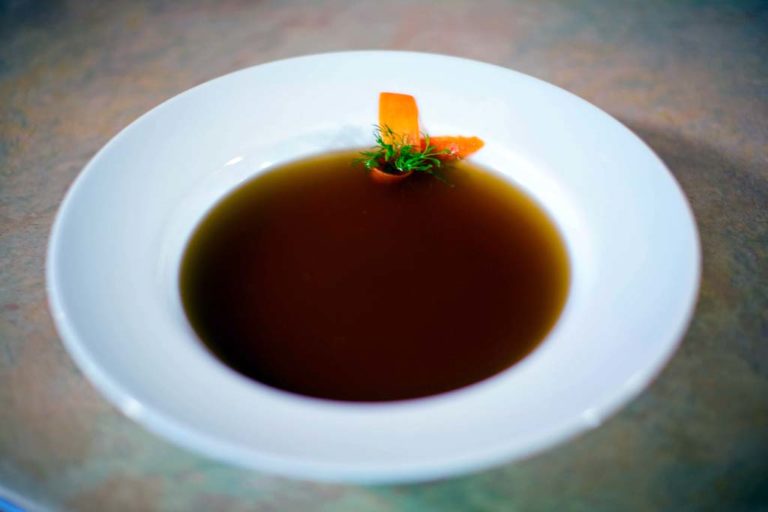
Chef's notes:
One of the most important stocks to a French chef is the brown stock. A brown stock is basically made the same way as a white stock, except the bones and vegetables are roasted first. Most chefs will use some combination of chicken, beef, and veal bones to make brown stock. What I’m doing here is making a basic brown veal stock (a.k.a. Fond de veau brun), using only veal bones. At a later date, I will make a brown stock using a mixture of bones. But today is all about those delicious, little, yellow veal bones. Oh, baby.
Ingredients
- 10 pounds veal bones (about ½ knuckles and ½ marrow bones)
- 5 medium-large onions, peeled and chunked
- 5 carrots, peeled and chunked
- 1½ Tbsp black peppercorns
- 5‒6 sprigs of thyme
- 2 bay leaves (laurel)
- Cool water to cover (6‒8 quarts)
Basic Brown Veal Stock (Fond de Veau Brun) Made with Mirepoix, Bouquet Garni and Roasted Veal Bones
- Purchase some veal bones. For a really good veal stock try to find a combination of marrow and knuckle bones. Knuckle bones have about twice as much collagen (i.e. gelatin) as other bones, so they make great stock. If yours have some meat still on the bone, that’s a bonus. Trim off any big chunks of fat.
- Roast the veal bones. Preheat an oven to 400‒425 degrees F. Give your bones a quick rinse under cool water and pat them dry with paper towels. Brush your largest roasting pan with a little oil and toss in your bones. Don’t season the bones with anything. Never add salt to a stock at any stage. Roast the bones for 1½‒2 hours. Flip them every 20 minutes, making sure they don’t burn.
- Roast the onions and carrots. Peel the onions and carrots and chop them into medium sized chunks. You may notice that I am not using celery; it has too strong a flavor, and would dominate every sauce or soup made with this stock. Roast the carrots and onions for about an hour—just until they get a tiny bit mushy and a little brown.
- Combine everything in the stock pot. Put the thyme, peppercorns and bay leaves in the bottom and add the vegetables. Remove the bones from the roasting pan with a slotted spoon or tongs, leaving the fat in the bottom of the pan. Dump the fat out and add some water; try to scrape up the fond (stuck-on bits). Add this to the pot. Add enough cool water to cover everything by 3‒4 inches. Skim off any floaters.
- Simmer the bones for 8‒12 hours. Heat the pot gradually until you have reached a low simmer. Do not boil at anytime! A gentle simmer is what you want, a temperature between 180‒190 degrees. The length of time you simmer will depend on how much gelatin you’ve extracted. If you have a lot of veal knuckles (cartilage), 8 hours will do.
- Skim off the scummy stuff as the veal mixture simmers. As the veal bones and vegetables simmer on the stove, skim off the stuff that floats to the top. This is perhaps the most tedious task of the whole affair. Skim as much as sanity allows. It’s important for the stock’s clarity, but if you miss a few floaters, it’s not the end of the world.
- Strain, filter and cool the veal stock. Use a china-cap, colander, or other fine mesh strainer to remove the little bits floating in the stock. Pass the whole thing through a few layers of cheesecloth a couple times—to get the finer floaters out. Taste the stock and reduce it if you need to concentrate the flavors. The best way to cool stock is to immerse the pot in ice water; stir until the temperature is below 120 degrees.
- Optional bonus round: Remouillage. Add more water to the bones and continue simmering. After 8‒12 hours, the bones have released only half what they have to offer. You can add more cool water and continue simmering the bones for another 10‒12 hours. Then, after you strain and filter that batch, reduce it to match the other. At this point, you can combine the two batches or continue reducing it until you have demi-glace!
Tips & Tricks
- Call butcher shops ahead of time to see if they have veal bones available, or if they need to special order them.
- Try to get an equal combination of veal knuckle (for the extra gelatin content), and marrow bones (for the rich flavor).
- Don’t add too many herbs or vegetables to your stock. You don’t want to give the stock too many flavors. Simple is best.
- Don’t stir the stock. Ever!
- Don’t boil the stock. Ever!
- Skim as much scum off of the top as you can without going mental.
- You might as well go for a second round of boiling that I mentioned in the last step. It’s basically a bonus of nummy stock!
- Cool the stock to 120 degrees or cooler before popping it in the fridge. Be safe, eh?
